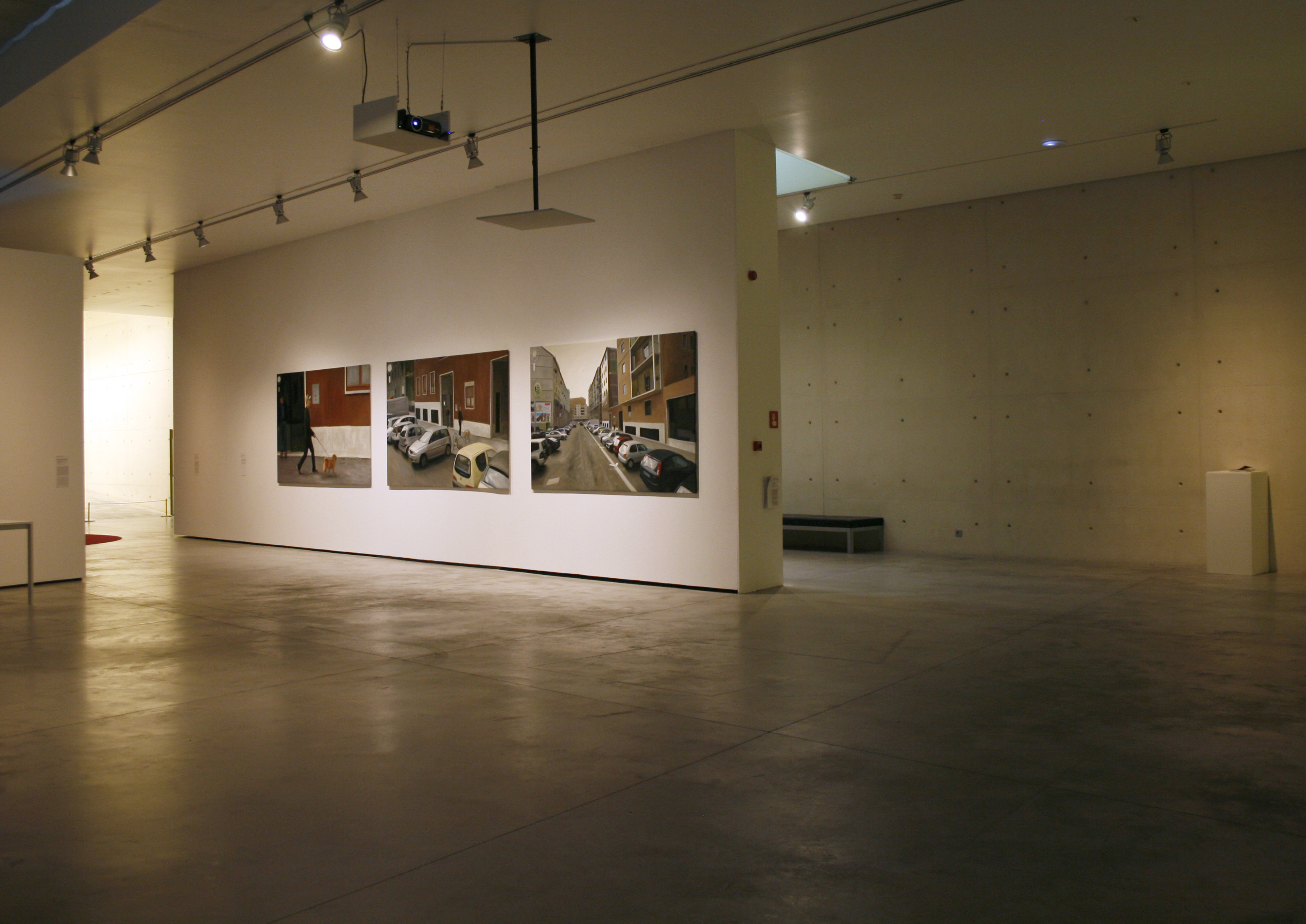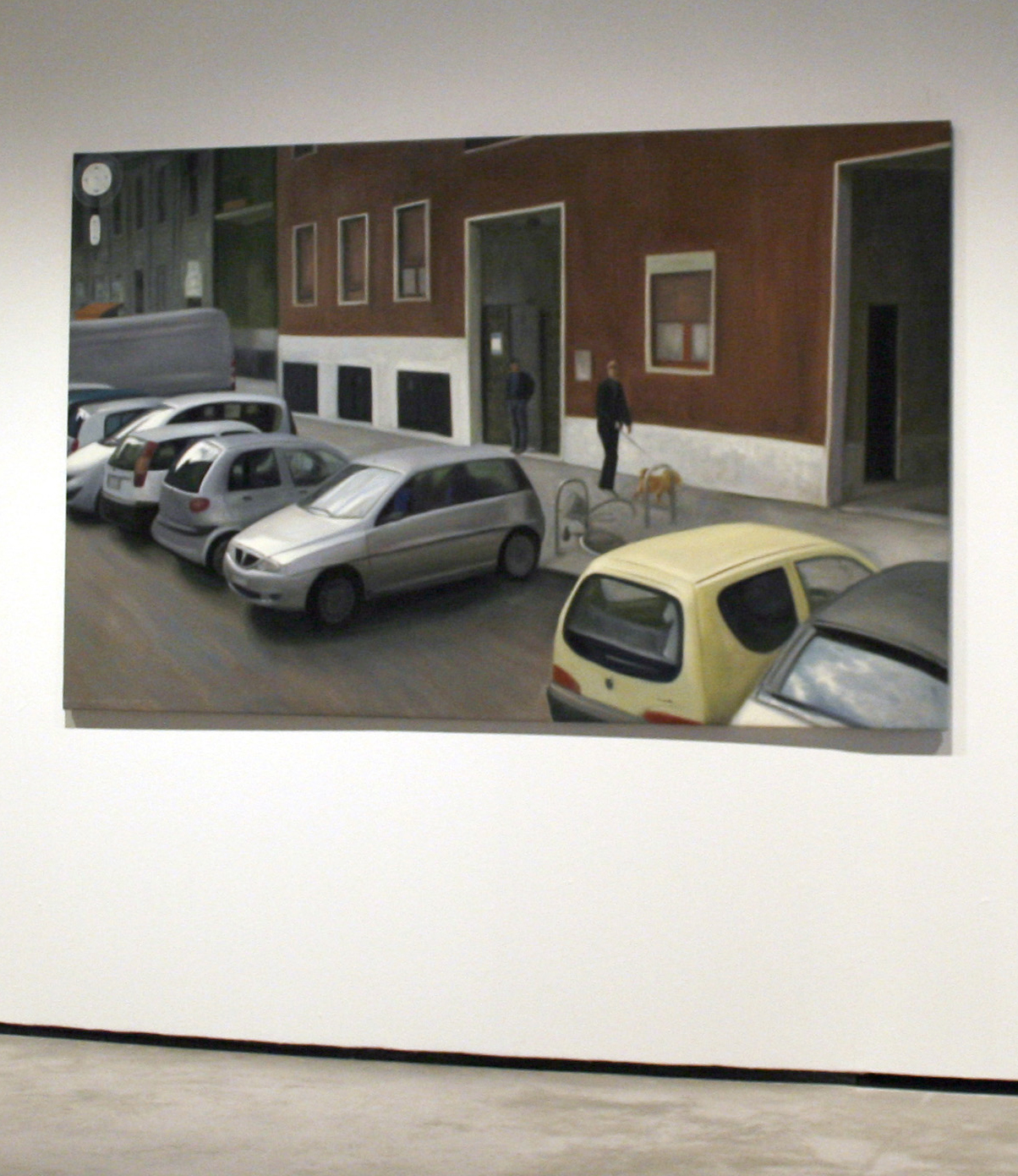Above: video documentation of Self Portrait With Dog, shot by the google car in the summer of 2008 in downtown Milano. The project is available at http://www.zanni.org/spwd
In 2008, an image of Carlo Zanni walking his dog appeared on the Google Street View of the street on which he lives. Zanni turned the surreptitiously captured image into a “self portrait” of our time, taken by an always watching camera eye without the subject’s consent and available for everyone to see as part of an online map. In its exploration of time and space, the image brings to mind the futurist artist Giacomo Balla’s painting Dynamism of a Dog on a Leash (1912). In late 2012 Zanni’s self portrait vanished from Google Street View, and all that remains now is an empty street, highlighting the time-based and ungovernable quality of online self-representation.
(Christiane Paul, label of the installation for THE PUBLIC PRIVATE, Sheila C. Johnson Design Center at Parsons, an Exhibition Exploring the Impact of Social Media and New Technologies. February 7 – April 17, 2013)
Paintings: This series of paintings was outsourced to a Chinese firm specialized in the reproduction of famous artworks, which made the paintings out of JPEGs. As the artist did not have any direct control of the Google car taking pictures of him on the street, he did not want to have any control over the painting process either.
ITA
Nel 2008, l’immagine di Carlo Zanni a spasso col suo cane è apparsa su Google Street View. Zanni ha trasformato l’immagine catturata in modo furtivo in un “autoritratto” del nostro tempo, scattato da una fotocamera sempre in funzione, senza il consenso del soggetto e disponibile a tutti come parte di una mappa online. Nella sua esplorazione del tempo e dello spazio, l’immagine riporta alla mente la pittura futurista Dinamismo di un cane al guinzaglio di Giacomo Balla (1912). A fine 2012 l’autoritratto di Zanni è sparito da Google Street View, e tutto ciò che rimane ora è una strada vuota, a mettere in evidenza la natura effimera dell’autorappresentazione online (Christiane Paul).
Dipinti: Questa serie di dipinti è stata affidata a uno studio di pittura cinese specializzato in copie di quadri famosi che li ha realizzati basandosi su delle immagini spedite via email. Come l’artista non ha avuto alcun controllo diretto sulla macchina di Google che lo ha fotografato, così non ha voluto avere tale controllo nanche sul processo pittorico.
Self Portrait With Dog PAINTINGS, 2010 – 2011
These series of paintings produced by Museo Es Baluard in Palma di Mallorca for Extimacy. Art, Intimacy and Technology curated by Pau Waelder, were outsourced to a chinese factory who made the paintings out of some JPEGS. As I didn’t have any direct control of the Google car shooting me on the street, I didn’t want to have such control over the painting process too.
Oil on canvas,150 x 240 cm each
vibo
The Artist Google Street View Photographed Twice
by JOANNE MCNEIL | Wed Dec 5th, 2012
source: rhizome.org
Could you tell me a little bit about the Google Street View pictures “Self Portrait with Dog” (2008) and “Self Portrait with Friends” (2012)?
They are part of an exploration around portraiture I began in 2000 designing desktop icons, programming cookies, and making google images generated drawings. In either cases, it’s me on the street in Milan being shot by the Google Car. The first one back in 2008, the second one in 2012. In “Self-Portrait With Dog,” I’m walking my dog and I choose that frame among others from the street view sequence (that you can still browse from the project’s homepage) because of its composition. It is also a classic theme in portraiture and it has a link to a famous work by futurist painter Giacomo Balla: “Dynamism of a Dog on a Leash”, 1912. Both explore the idea of time and space, with mine having strong ties with very urgent themes like public exposure, privacy and control. In “Self-Portrait With Friends (i fannulloni)” I’ve been shot with two pals while lying around like slackers. “i fannulloni” — that is the wall writing on the left of the picture — means slackers. You might find an assonance with “I Vitelloni” by Federico Fellini. Even in this case, I chose this frame for its composition values and when shown in gray scale as it has to be, its “neo realistic” side pops up. Naming these works “self portraits”, and not “portraits made by Google” — like suggested by curator Pau Waelder — ironically plays with the idea that I had a direct control on the execution of the project, which I didn’t; employing as a medium the corporation that actually took control and owns rights of the public space and its content. They are probably the most simple projects I ever did so far and at the same time the most difficult ones. I think they come out so perfect because I didn’t do almost anything. In my mind they are like pure thought.
Getting your picture taken by Google Street View twice was just luck? Or did you have an idea that they were photographing the neighborhood? What are your thoughts on Street View?
Yes yes, it was just luck. I had no control. Street view is a great tool but the way it was implemented (imposed) was, in my opinion, at least questionable. They made private agreements with governments to scan the globe skipping any kind of people’s feedback, people who happen to be the subjects, beside the public environment, of this pretty intrusive practice. I would be interested to know if these agreements were “economic”. This is an important step because in the end all the Street View material is copyrighted and private owned, resulting in contradiction with the subject matter, and of course, above all when you find yourself featured in it twice. Apart from sniffing kinda private data broadcasted via wifi (I’ve no idea what the goal was or if this happened on purpose) they shouldn’t had used unmarked cars to make their first rides through the cities. Of course we could say it’s more a Gov’s lack than their fault, but when dealing so evidently with personal privacy I think they should had been more careful. In the end we all accepted it enthusiastically, emphasizing the common practice of being accomplices in an endless leak of personal privacy (Political profiling through Facebook) that doesn’t match the same aim for a full transparency of the public administration.
Street View helped to solve a kidnapping crime and inspired this amazing way of lose yourself around but the very best feature is yet to come, and it deals with history*. After discovering myself on Street View the first time in 2008, I was telling everybody that as time passes and the Google car keeps crawling, we’d have disappeared from that spot and selfportraitwithdog.com would end in a different picture, with no me and no dog in it, except for a caption at the bottom of the screen recalling the old project. What is happening instead, is that even if we are gone from that spot http://goo.gl/maps/6c6jE we are still there if you access the same section from the art project. And you can browse it of course. So, it’s like Google is keeping Street View layers from previous years, but it shows only the latest one except you have saved an old address, like mine pointing to “Self Portrait With Dog”. I think they are working on a Street View Time Machine to let people browse a selected area back in time. This will be of extreme help for historian and urbanists to name a few and gives an unpredictable depth and a final raison d’être to a contemporary apparatus.

